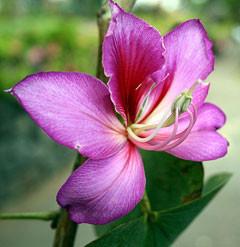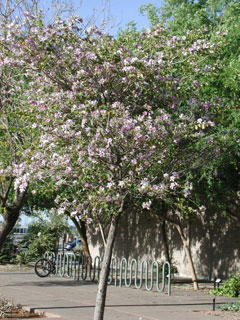 |
|
http://commons.wikimedia.org/wiki/User:Hedwig_Storch |
 |
| http://commons.wikimedia.org/wiki/User:Epibase |
Translate this page:
Summary
Physical Characteristics

 Bauhinia variegata is a deciduous Tree growing to 12 m (39ft 4in).
Bauhinia variegata is a deciduous Tree growing to 12 m (39ft 4in).
See above for USDA hardiness. It is hardy to UK zone 9. The species is hermaphrodite (has both male and female organs).
Suitable for: light (sandy), medium (loamy) and heavy (clay) soils. Suitable pH: mildly acid and neutral soils and can grow in saline soils.
It can grow in semi-shade (light woodland) or no shade. It prefers moist or wet soil.
UK Hardiness Map
US Hardiness Map
Synonyms
Plant Habitats
Woodland Garden Sunny Edge;
Edible Uses
Edible Parts: Leaves
Edible Uses:
The young leaves, flowers and fruits are boiled and eaten as a vegetable, or are pickled[272].
References More on Edible Uses
Medicinal Uses
Plants For A Future can not take any responsibility for any adverse effects from the use of plants. Always seek advice from a professional before using a plant medicinally.
Alterative Anthelmintic Astringent Dysentery Tonic
The bark is alterative, anthelmintic, astringent and tonic[243, 272]. The juice of the bark is used in the treatment of amoebic dysentery, diarrhoea and other stomach disrders[272]. A paste of the bark is useful in the treatment of cuts and wounds, skin diseases, scrofula and ulcers[243, 272]. The dried buds are used in the treatment of piles, dysentery, diarrhoea and worms[243]. The juice of the flowers is used to treat diarrhoea, dysentery and other stomach disorders[272]. The root is used as an antidote to snake poison[243]. A decoction of the root is used to treat dyspepsia[243].
References More on Medicinal Uses
The Bookshop: Edible Plant Books
Our Latest books on Perennial Plants For Food Forests and Permaculture Gardens in paperback or digital formats.

Edible Tropical Plants
Food Forest Plants for Hotter Conditions: 250+ Plants For Tropical Food Forests & Permaculture Gardens.
More

Edible Temperate Plants
Plants for Your Food Forest: 500 Plants for Temperate Food Forests & Permaculture Gardens.
More

More Books
PFAF have eight books available in paperback and digital formats. Browse the shop for more information.
Shop Now
Other Uses
Dye Fodder Tannin Wood
The bark is a source of tannins. It is used for dyeing[272]. Wood - used for house construction and making household implements[272]. A very popular ornamental tree in subtropical and tropical climates, grown for its scented flowers. The leaves, shoots and pods of B. variegata are used as fodder for livestock, including sheep, goats and cattle. Average leaf yield from a mature tree is about 20-22 kg fresh weight per annum. Erosion control or dune stabilization,
Shade and shelter,
Windbreak. Fuels:Charcoal, Fuelwood.
Special Uses
References More on Other Uses
Cultivation details
Prefers a fertile, moisture-retentive but well-drained soil, requiring a warm sheltered position in full sun[200, 260]. When grown in warm Temperate zones, this species can withstand short periods of temperatures as low as -5°c[200]. In Britain, it is only likely to succeed outdoors in the very mildest parts of the country, and even then would probably require the protection of a south-facing wall. There are some cultivars, developed for their ornamental value[200]. 243034
References Carbon Farming Information and Carbon Sequestration Information
Temperature Converter
Type a value in the Celsius field to convert the value to Fahrenheit:
Fahrenheit:
The PFAF Bookshop
Plants For A Future have a number of books available in paperback and digital form. Book titles include Edible Plants, Edible Perennials, Edible Trees,Edible Shrubs, Woodland Gardening, and Temperate Food Forest Plants. Our new book is Food Forest Plants For Hotter Conditions (Tropical and Sub-Tropical).
Shop Now
Plant Propagation
Seed - pre-soak for 12 hours in warm water then sow in mid spring in a greenhouse. When large enough t handle, prick the seedlings out into individual pots and grow them on in the greenhouse for at least their first winter. Plant out in early summer, after the last expected frosts and consider giving some protection from the cold for their first winter or two outdoors. Cuttings of half-ripe wood, with the leaves removed, in moist sand July/August in a frame[200]. Gentle bottom heat is usually required. Layering.
Other Names
If available other names are mentioned here
Buddhist bauhinia; butterfly tree; kachnar; orchid tree; paper mulberry; pink orchid tree; poor man's orchid; purple orchid tree.
Spanish: gorro de Napoleón; mariposa; orchidea de pobre; orquidea de palo; puente de mono.
French: arbre à orchidées; arbre de Saint-Thomas; bois de boeuf; sabot boeuf.
Chinese: yang zi jing.
Portuguese: árvore-de-São-Thomaz.
Bangladesh: rakta-kamhar; swet-kanchan.
Brazil: unha-de-vacca.
Cuba: bauhinia.
Dominican Republic: flamboyán; orquídea.
Haiti: flamboyant.
India: bahari kachnar; barial; bogakatra; bondantam; borara; botantam; chemmandarei; chuvanna-mandara; devakanchanaman; deva-kanchanmu; guiral; kachan; kachnar; kaliar; kanarai; kanchanar; kanchavala; kanchavalado; khwairai; kotava; kotidaram; kotora; kovidara; kurol; mandari; padrian; rakta-kamhar; raktha-kanchan; segapu-manchori; swet-kanchan; tamrapushpi; thaur
Malaysia: akbar tapak kerbau; kotidaram; kupu-kupu.
Nepal: koiralo.
Pakistan: kachnar.
Puerto Rico: palo de orquídeas.
Native Range
TEMPERATE ASIA: China (Fujian Sheng, Guangdong Sheng, Yunnan Sheng, Guangxi Zhuangzu Zizhiqu) TROPICAL ASIA: Bhutan, India (Sikkim, Andhra Pradesh, Assam, Bihar, Gujarat, Haryana, Himachal Pradesh, Jammu and Kashmir, Kerala, Madhya Pradesh, Maharashtra, Manipur, Meghalaya, Nagaland, Odisha, Punjab, Rajasthan, Tamil Nadu, Tripura, Uttar Pradesh, West Bengal, Karnataka, Delhi, Goa, Mizoram, Puducherry, Arunachal Pradesh), Nepal, Pakistan, Laos, Myanmar, Thailand (northwest), Vietnam
Weed Potential
Right plant wrong place. We are currently updating this section.
Please note that a plant may be invasive in one area but may not in your area so it's worth checking.
Once established, B. variegata This plant can be weedy or invasive. Often become weedy and it has the potential to displace native vegetation. It is also difficult to manage because its seeds can remain viable for more than a year [1d]. In the US it is a noted weed in Florida.
Conservation Status
IUCN Red List of Threatened Plants Status : Least Concern.

Growth: S = slow M = medium F = fast. Soil: L = light (sandy) M = medium H = heavy (clay). pH: A = acid N = neutral B = basic (alkaline). Shade: F = full shade S = semi-shade N = no shade. Moisture: D = dry M = Moist We = wet Wa = water.
Now available:
Food Forest Plants for Mediterranean Conditions
350+ Perennial Plants For Mediterranean and Drier Food Forests and Permaculture Gardens.
[Paperback and eBook]
This is the third in Plants For A Future's series of plant guides for food forests tailored to
specific climate zones. Following volumes on temperate and tropical ecosystems, this book focuses
on species suited to Mediterranean conditions—regions with hot, dry summers and cool, wet winters,
often facing the added challenge of climate change.
Read More
Expert comment
Author
L.
Botanical References
200
Links / References
For a list of references used on this page please go here
Readers comment